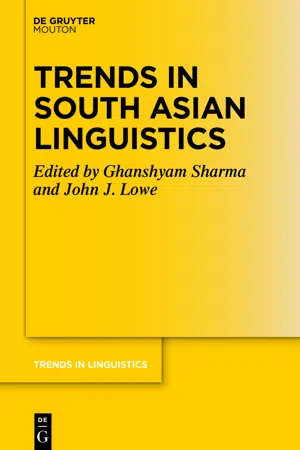
- 495 pages
- English
- ePUB (mobile friendly)
- Available on iOS & Android
Trends in South Asian Linguistics
About This Book
The field of South Asian linguistics has undergone considerable growth and advancement in recent years, as a wider and more diverse range of languages have become subject to serious linguistic study, and as advancements in theoretical linguistics are applied to the rich linguistic data of South Asia. In this growth and diversity, it can be difficult to retain a broad grasp on the current state of the art, and to maintain a sense of the underlying unity of the field. This volume brings together twenty articles by leading scholars in South Asian linguistics, which showcase the cutting-edge research currently being undertaken in the field, and offer the reader a comprehensive introduction to the state of the art in South Asian linguistics. The contributions to the volume focus primarily on syntax and semantics, but also include important contributions on morphological and phonological questions. The contributions also cover a wide range of languages, from well-studied Indo-Aryan languages such as Sanskrit, Hindi, Bangla and Panjabi, through Dravidian languages to endangered and understudied Tibeto-Burman languages. This collection is a must-read for all scholars interested in current trends and advancements in South Asian linguistics.
Frequently asked questions
Information
A cross-linguistic approach to sentential subjects in Kannada
Abstract
1 Introduction
Table of contents
- Title Page
- Copyright
- Contents
- Preface
- On the syntax of comparative clauses in Vedic Sanskrit … like someone eating the foam off the water
- Some questions about yád in Vedic
- A statistical model of syntactic and non-syntactic factors affecting relative clause placement in Hindi
- Optionality and variation in agreement in some participles in Hindi-Urdu
- A cross-linguistic approach to sentential subjects in Kannada
- Relation between animacy and case marking in Eastern Indo-Aryan languages
- Participles with a semantic void in Koints
- Competition between vectored verbs and factored verbs in Hindi-Urdu, Marathi and Gujarati
- How similarly do Hindi rakhnā and Japanese oku PUT behave as a V2? A corpus-based comparative analysis
- The use of vector verbs in early modern Tamil
- Reflexive and reciprocal marking in Mising
- Reciprocals in Kokborok — A Case of Syntactic Convergence
- A cognitive semantic analysis of locative and spatial constructions in Bangla
- Revisiting Pāṇini’s generative power
- Hindi root allomorphy: Insights from phonological and morphosyntactic theory
- Lexeme and speech syllables in English and Hindi. A case for syllable structure
- List of contributors
- Index of authors
- Index of languages
- Index of subjects